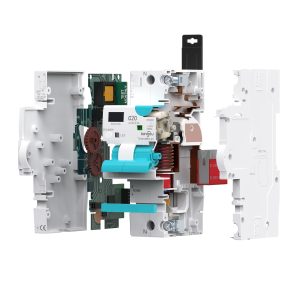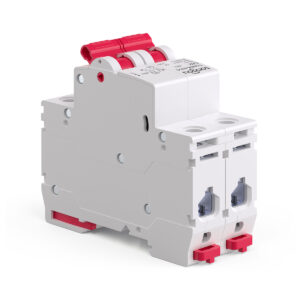
RCBO Trips at Night? Causes, Diagnosis, and Lasting Fixes
RCBO Trips at Night? Causes, Diagnosis, and Lasting Fixes Already know what an RCBO is? Great. This page skips the basics and focuses on nocturnal
A double pole single throw (DPST) switch, also known simply as a double pole switch, is an electrical switch that controls two separate circuits simultaneously with one action — ON or OFF.
This means both live connections can be isolated together, providing higher safety and flexibility across 110V, 220V, or 240V systems used worldwide.
In contrast to a single pole switch, which only controls one line, a double pole switch disconnects both power lines at the same time — ensuring complete circuit isolation.
This makes it ideal for heating systems, heavy machinery, lighting circuits, and modern smart homes that require higher voltage protection.

To understand why many electricians and engineers choose a double pole switch, it helps to compare it with its simpler counterpart:
| Feature | Single Pole Switch | Double Pole Switch |
|---|---|---|
| Controlled Circuits | 1 | 2 |
| Isolation | Partial | Full |
| Use Case | Lights, fans | Motors, water heaters, appliances |
| Safety Level | Basic | High |
| Smart Version | Single smart switch | Double pole smart switch |
A single pole switch interrupts one live wire — leaving another potentially active.
A double pole single throw switch, however, cuts both live conductors, creating complete disconnection.
Because both lines carry significant potential, simply interrupting one line does not guarantee a safe de-energized state.
Think of it as two identical single switches controlled by one lever.
When flipped ON, both circuits close; when turned OFF, both open — ensuring simultaneous control.
L1 ——/ —— Load 1
L2 ——/ —— Load 2
Each “/” symbol represents one pole of the switch. Both open or close together.
This design ensures safe operation in systems where two conductors carry voltage — such as many global 220–240V networks or industrial control systems.
Because power systems vary globally, the double pole switch adapts to multiple standards and uses:
—Used in 240V circuits for water heaters, cookers, or high-power outlets.
—In North America, double pole breakers and switches safely isolate both hot wires in split-phase systems.
—Controls motors, pumps, and HVAC equipment that require dual-line isolation.
—Prevents accidental energizing during servicing.
—A double pole light switch can control large lighting zones or 2-phase LED systems.
—Smart variants can be integrated with automation systems.
—A double pole smart switch merges electrical safety with remote operation — combining relay isolation with IoT technology.
—Ideal for factories, smart buildings, and renewable energy setups.
As homes and industries move toward automation, traditional switches are being replaced by WiFi-enabled smart switches.
However, not all are designed for high-voltage or dual-line systems.
That’s where the double pole smart switch comes in — combining DPST safety with intelligent control.
Complete circuit isolation for both live lines
Remote ON/OFF control via app (Tuya, Smart Life, etc.)
Real-time energy monitoring
Timer and scheduling features
Overvoltage, overcurrent… protection
To ensure maximum durability under heavy loads, this device utilizes a high-performance relay from HONGFA, a global leader in relay technology known for components that offer high durability and over 100,000 mechanical operations. For distributors, this means fewer failures and a stronger brand reputation.
how to wire a tongou double pole switch
Even high-quality double pole switches can face occasional issues due to installation or environmental factors.
Here are some common symptoms, possible causes, and recommended solutions:
| Symptom | Possible Cause | Suggested Fix |
|---|---|---|
| Load still receives power when switch is “OFF” | Wrong wiring or single-pole switch used | Verify wiring and use a proper double pole switch to fully isolate both lines |
| Flickering or unstable control | Voltage sag or surge | Check voltage range tolerance; install overvoltage / undervoltage protection |
| App shows no connectivity (for smart models) | WiFi or 4G signal issue | Reconfigure the IoT platform, update firmware, and test network strength |
| Overload trips frequently | Load current too close to rated limit | Reduce load, upgrade switch rating, and leave 20–30% safety headroom |
| Switch failure after repeated cycles | Relay wear or poor contact quality | Choose a model with a high mechanical endurance rating |
Q1: Can I use a single-pole smart switch if one live line is neutral?
If your system is truly L-N, a single-pole switch may suffice; but in split-phase (L-L) environments, it’s unsafe.
Q2: What happens if someone accidentally reverses L1 and L2?
A correct double-pole design should be polarity-insensitive; ensure device supports both orientations safely.
Q3: Is it okay to share neutral conductors?
Only if the device is designed to safely manage or isolate neutral; this complicates design and is best avoided.
Q4: Do I need both over-voltage and under-voltage protection?
Yes — grid instability, especially in remote areas, can cause either overvoltage surges or voltage drops, both harmful.
Q5: How do I validate a switch’s true double-pole behavior?
Use a multimeter to measure voltage at the load terminals when the switch is OFF — both lines should read zero.

Johnson Lim is the General Manager of Changyou Technology and has over 10 years of experience in circuit protection technology and residential electrical safety. He is committed to developing and producing safer and smarter electrical products.

RCBO Trips at Night? Causes, Diagnosis, and Lasting Fixes Already know what an RCBO is? Great. This page skips the basics and focuses on nocturnal

MCB B/C/D Curves in Practice: How Inrush Current Shapes Your Choice This guide assumes you already know what an MCB is. If you need a

SPD Coordination for Solar PV and EV Charging: Where to Place Type 1/2/3 Already know the difference between Type 1/2/3 and AC vs DC SPDs?

MCB vs MCCB: A Practical Guide to Icu/Ics and IEC 60898 vs 60947-2 This guide assumes you already know what a breaker is. If you

tongou was established in 1993 and is the trademark of Changyou Technology. We position ourselves as providers of intelligent product solutions for high and low voltage electrical systems, taking on solving customers’ pressures and challenges as our responsibility and creating value for them. We utilize intelligent products to serve global customers, making life smarter and more convenient to benefit your life.
Paidong Industrial Zone Qiligang,Yueqing City,Zhejiang province,China.
Sales: [email protected]
After-sales: [email protected]
© 2025 Changyou Technology. All Rights Reserved.

